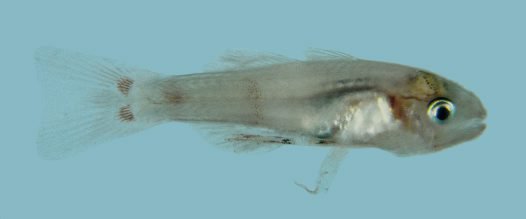A coral-reef fish with large, fast, conspicuous larvae and small, cryptic adults
In most coral reef fishes, larvae are tiny and transparent, and adults large and boldly coloured; but in one species, the opposite is true.

© bluereefphoto.org
Larvae of the inconspicuous spot-tail cardinalfish settle onto the reef at 20-25 mm, are extremely conspicuous in shape and colour and cruise over the reef at night flaunting their finery. In contrast, the adults are small, live in holes and caves, and are never seen by divers. This is a wonderful example of how evolution can shape the pre- and post-settlement portions of a reef fish’s life differently.
Nearly all fishes that live on coral reefs have a two-phase life history, with larvae that live in open water for a couple of weeks to a couple of months before – hopefully – finding a reef upon which to settle and metamorphose into boldly-coloured adults that spend the rest of their lives closely associated with the reef. Larvae are typically small and transparent even near the end of their larval phase when they are searching for a place to settle.
The spot-tail cardinalfish (Gymnapogon urospilotus), which is found on coral reefs from Tahiti in the east to the western Indian Ocean is an exception – the largest adult ever recorded is only 39 mm long, and largely transparent. It is so secretive that it is never seen by divers on the reef.

© Royal Ontario Museum
On the other hand, we found that its larvae are spectacularly conspicuous in both morphology and behaviour, with very long, brightly coloured pelvic-fin rays: features that are lost at metamorphosis. Plus, it is the largest (up to 20-25 mm) cardinalfish species at settlement. So, on the basis of size, this species spends a very large proportion – perhaps half - of its life as a larva out in the pelagic environment, and relatively little on the reef. Maybe it is best regarded as a pelagic fish with a reef-living reproductive phase!
Larval spot-tail cardinalfish are also the fastest cardinalfish larvae, swimming faster than 20 body lengths per second – pretty impresive compared to human Olympic swimmers, who can only manage about 2 body lengths per second.

© National Museum of Natural History, Smithsonian Institution
When the same animal lives in two such different environments during its life history, evolution can produce very different results in both body shape and behaviour in those two life phases. The spot-tail cardinalfish is a wonderful example of this.
Most adult reef fishes move little from where they had settled onto the reef. So, the populations of reef fishes on different islands and reefs are connected genetically and demographically only by larvae dispersing through the pelagic ocean.In spite of the large size at settlement and relatively long pelagic larval duration of the spot-tail cardinalfish, preliminary analysis of its population genetics on different islands indicates that few, if any of its larvae disperse from one island group to another. Perhaps it is the large size and good swimming ability of the larvae that enables them to remain close to the reef where their parents live rather than travel far from home.
Dr Jeffrey M Leis
Senior Fellow in Ichthyology, AMRI
More information:
Leis, J. M., O. Meyer, A.C. Hay and M. R. Gaither (2015). A coral-reef fish with large, fast, conspicuous larvae, and small, cryptic adults (Teleostei: Apogonidae). Copeia 103(1): 78-86. DOI 10.1643/CG-14-119












